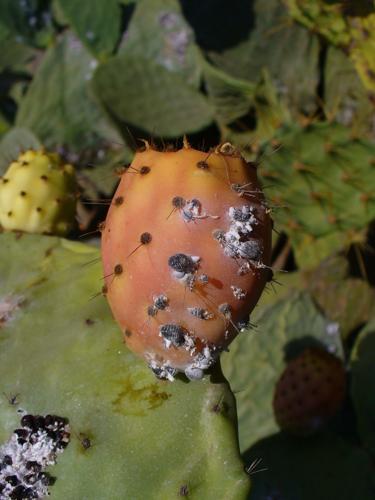Q: There are small insects about 2-3 millimeters long that are eating (and killing) our Mexican pink flowered Oenothera. I put a pan underneath the damaged leaves and knocked about five off. They have killed about three-quarters of my plants, mostly those in the sun. Part is behind a wall that only has eastern light in the early morning and also is under the place in the eaves where the water rushes off the roof and so far they look healthy, so I will be able to replant.
A: The insects in the photo are larvae of the apple flea beetle (Altica foliaceae). They are common across the United States. In the west they are commonly found on evening primrose. When populations of these beetles are high, as they often are in the late summer and into fall in southern Arizona, they can do a lot of chewing damage. While there are some insecticides available for managing leaf beetles, these insects can also be ignored this late in the growing season. Since the Mexican evening primrose is a tough plant that will grow back from the roots, you can simply cut it back to the stem. This also serves to reduce places for the beetles to spend the winter. If you desire to spray them regardless, the least toxic chemicals include insecticidal soap with pyrethrin and neem products.
Q: We live just above River Road with desert vegetation. A branch of five of what I think is Yucca elata, 3 to 4 feet high, has grown up close to the street edge and my mailbox. All branches look healthy. Would it be possible to separate the bunch, leave only the best one or two, and transplant the others? I hate to just cut down the three or four branches impinging on the street/mailbox since they all look nice.
A: It is possible to prune off the branches you want to transplant. It is important to let the cuttings harden off for about a week after you cut them and before you transplant them. Some people use a rooting hormone on the cut end before planting, although that is not required. Also you might want to cut the cuttings down to size if they are too large to stand up on their own when planted. Otherwise you can prop them up until they establish roots.
Q: I have a backyard prickly pear with a cochineal infestation. Does that need to be treated? Do these guys ever go away on their own? Are they even actually a problem for the cactus?
A: Cochineal scale insects (Dactylopius species) suck sap from prickly pear cacti and large populations can reduce the vigor of the plants. Treating them is optional. They are noticeable due to the cottony wax the females generate to shelter themselves and their egg masses and this waxy material protects them from the environment and insecticides to some degree. The eggs hatch into nymphs (called crawlers) that feed for about three weeks before settling and becoming immobile. The crawler stage is when they spread their population on cactus plants. Once settled, they produce the waxy material that shelters them from predators and the weather. Multiple generations are produced each year. While these insects utilize the plant for food, the damage is usually negligible. If a plant is seriously colonized and showing signs of decline, you can prune off the worst pads and discard them (always prune at the joints). Blast the remaining portion of the plant with a high-pressure hose. This should expose and weaken the insects. Then spray the exposed scale with an insecticidal soap or horticultural oil. These low toxicity insecticides will minimize harmful effects on beneficial insects. Treating them is best done when the crawlers are active since they are the weakest link in their life cycle. This often occurs in the late winter or early spring for the first generation of the year.
Q: I planted a blue glow agave in a large pot about seven years ago. It has done beautifully until recently. I water it weekly in the summer and maybe one to two times a month in the winter or less if we get rain. The frost nipped it in the spring even though I covered it. Recently it was damaged in a storm by the hail. The last two weeks I have noticed that the leaves are becoming mottled and yellowing. Today there are small flying insects all over it. Are these insects causing this issue? I’m afraid the plant is a lost cause at this point. Hope the photos can help you identify it.
A: What you are seeing is the agave plant bug (Caulotops distanti). These insects suck plant sap from agaves and over time will cause discoloration of the leaves, the mottling and yellowing you described, and reduce the vigor of the plant. You can treat the plant with a pyrethrin insecticide to reduce the population and hopefully save the plant. There are also systemic insecticides that can be used as a soil drench to manage this pest in the long term. It takes a while for the plant to translocate the insecticide from the roots to the leaves. It may take a while to come back from severe insect damage so you will have to decide whether to give it a try or start over.






